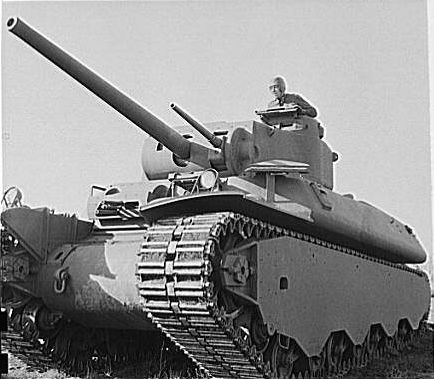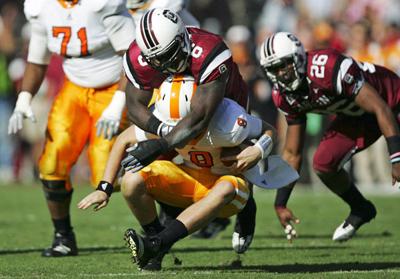USS Enterprise (CV-6)
.jpg/1280px-USS_Enterprise_(April_1939).jpg)
_on_4_June_1942_(80-G-41686).jpg/1280px-Douglas_TBD-1_Devastators_of_VT-6_are_spotted_for_launch_aboard_USS_Enterprise_(CV-6)_on_4_June_1942_(80-G-41686).jpg)
U.S. Navy Torpedo Squadron 6 (VT-6) Douglas TBD-1 Devastator aircraft are prepared for launching aboard the aircraft carrier USS Enterprise (CV-6) at about 0730-0740 hrs, 4 June 1942. Eleven of the fourteen TBDs launched from Enterprise are visible. Three more TBDs and ten Grumman F4F-4 Wildcat fighters must still be pushed into position before launching can begin.
The TBD in the left front is Number Two (BuNo 1512), flown by Ensign Severin L. Rombach and Aviation Radioman 2nd Class W.F. Glenn. Along with eight other VT-6 aircraft, this plane and its crew were lost attacking Japanese aircraft carriers a little more than two hours later. The heavy cruiser USS Pensacola (CA-24) is in the distance on the right and a destroyer is in plane guard position at left.
A Japanese bomb explodes on the flight deck of Enterprise on 24 August 1942, during the Battle of the Eastern Solomons, causing minor damage. (below)
_flight_deck_during_Battle_of_the_Eastern_Solomons,_24_August_1942_(80-G-17489).jpg/1280px-Japanese_bomb_hits_USS_Enterprise_(CV-6)_flight_deck_during_Battle_of_the_Eastern_Solomons,_24_August_1942_(80-G-17489).jpg)
A Japanese bomb explodes on the flight deck of USS Enterprise, 24 August 1942 during the Battle of the Eastern Solomons, causing minor damage. This was the third and last bomb to hit Enterprise during the battle. The bomb was dropped by a Japanese Aichi D3A1 "Val" dive bomber piloted by Kazumi Horie who died in the attack.
According to the original photo caption in the US Navy's archives, this explosion killed the photographer, Photographer's Mate 3rd Class Robert F. Read. This image, however, was actually taken by Photographer's Mate 2nd Class Marion Riley, who was operating a motion picture camera from the aft end of the ship's island, above the flight deck and who survived the battle although his photographic equipment was damaged.
The film Riley took that day, and of which this still was extracted together with others and published in Life magazine, can be seen in the YouTube video posted below (explosion at 03:05). Robert Read was stationed in the aft starboard 5" gun gallery and was killed by the second bomb to hit Enterprise. The smoke from the bomb explosion that killed Read can be seen in the upper left of this photograph.
Paying attention to the rapidly changing angles of the flight deck against the horizon will tell you the extremes that Enterprise was maneuvering to avoid it's Japanese attackers.
GIs in the hangar bay of Enterprise in 1945. (below)
_during_a_Magic_Carpet_voyage,_in_September_1945_(80-G-495657).jpg/1280px-Hangar_of_USS_Enterprise_(CV-6)_during_a_Magic_Carpet_voyage,_in_September_1945_(80-G-495657).jpg)
Returning veterans of the Pacific fill the hangar deck of the U.S. Navy aircraft carrier USS Enterprise (CV-6) as it stopped in Pearl Harbor, Territory of Hawaii, preparatory to moving to the United States. Enterprise sailed to Pearl Harbor in late August 1945, returning to the States with some 1,141 servicemen due for discharge, including hospital patients and former prisoners-of-war. She then sailed on to New York on 25 September 1945 via the Panama Canal arriving on 17 October 1945. From November 1945 to January 1946, she transported returning servicemen from Europe.
The stern plate of USS Enterprise located in River Vale, New Jersey. (below)

The ship's insignia of Enterprise. (below)
_1938.png/1024px-Insignia_of_USS_Enterprise_(CV-6)_1938.png)
https://en.wikipedia.org/wiki/USS_Enterprise_(CV-6)
.jpg/1280px-USS_Enterprise_(April_1939).jpg)
VT-6 TBDs on USS Enterprise during the Battle of Midway. (below)USS Enterprise (CV-6) was a Yorktown-class carrier built for the United States Navy during the 1930s. She was the seventh U.S. Navy vessel of that name. Colloquially called "The Big E", she was the sixth aircraft carrier of the United States Navy. Launched in 1936, she was one of only three American carriers commissioned before World War II to survive the war (the others being Saratoga and Ranger). She participated in more major actions of the war against Japan than any other United States ship.
These actions included the attack on Pearl Harbor — 18 Douglas SBD Dauntless dive bombers of her Air Group arrived over the harbor during the attack; seven were shot down with eight airmen killed and two wounded, making her the only American aircraft carrier with men at Pearl Harbor during the attack and the first to sustain casualties during the Pacific War — the Battle of Midway, the Battle of the Eastern Solomons, the Battle of the Santa Cruz Islands, various other air-sea engagements during the Guadalcanal Campaign, the Battle of the Philippine Sea, and the Battle of Leyte Gulf. Enterprise earned 20 battle stars, the most for any U.S. warship in World War II, and was the most decorated U.S. ship of World War II.
She was also the first American ship to sink a full-sized enemy warship after the Pacific War had been declared when her aircraft sank the Japanese submarine I-70 on 10 December 1941. On three occasions during the war, the Japanese announced that she had been sunk in battle, inspiring her nickname "The Grey Ghost". By the end of the war, her planes and guns had downed 911 enemy planes, sunk 71 ships, and damaged or destroyed 192 more.
_on_4_June_1942_(80-G-41686).jpg/1280px-Douglas_TBD-1_Devastators_of_VT-6_are_spotted_for_launch_aboard_USS_Enterprise_(CV-6)_on_4_June_1942_(80-G-41686).jpg)
U.S. Navy Torpedo Squadron 6 (VT-6) Douglas TBD-1 Devastator aircraft are prepared for launching aboard the aircraft carrier USS Enterprise (CV-6) at about 0730-0740 hrs, 4 June 1942. Eleven of the fourteen TBDs launched from Enterprise are visible. Three more TBDs and ten Grumman F4F-4 Wildcat fighters must still be pushed into position before launching can begin.
The TBD in the left front is Number Two (BuNo 1512), flown by Ensign Severin L. Rombach and Aviation Radioman 2nd Class W.F. Glenn. Along with eight other VT-6 aircraft, this plane and its crew were lost attacking Japanese aircraft carriers a little more than two hours later. The heavy cruiser USS Pensacola (CA-24) is in the distance on the right and a destroyer is in plane guard position at left.
A Japanese bomb explodes on the flight deck of Enterprise on 24 August 1942, during the Battle of the Eastern Solomons, causing minor damage. (below)
_flight_deck_during_Battle_of_the_Eastern_Solomons,_24_August_1942_(80-G-17489).jpg/1280px-Japanese_bomb_hits_USS_Enterprise_(CV-6)_flight_deck_during_Battle_of_the_Eastern_Solomons,_24_August_1942_(80-G-17489).jpg)
A Japanese bomb explodes on the flight deck of USS Enterprise, 24 August 1942 during the Battle of the Eastern Solomons, causing minor damage. This was the third and last bomb to hit Enterprise during the battle. The bomb was dropped by a Japanese Aichi D3A1 "Val" dive bomber piloted by Kazumi Horie who died in the attack.
According to the original photo caption in the US Navy's archives, this explosion killed the photographer, Photographer's Mate 3rd Class Robert F. Read. This image, however, was actually taken by Photographer's Mate 2nd Class Marion Riley, who was operating a motion picture camera from the aft end of the ship's island, above the flight deck and who survived the battle although his photographic equipment was damaged.
The film Riley took that day, and of which this still was extracted together with others and published in Life magazine, can be seen in the YouTube video posted below (explosion at 03:05). Robert Read was stationed in the aft starboard 5" gun gallery and was killed by the second bomb to hit Enterprise. The smoke from the bomb explosion that killed Read can be seen in the upper left of this photograph.
Paying attention to the rapidly changing angles of the flight deck against the horizon will tell you the extremes that Enterprise was maneuvering to avoid it's Japanese attackers.
GIs in the hangar bay of Enterprise in 1945. (below)
_during_a_Magic_Carpet_voyage,_in_September_1945_(80-G-495657).jpg/1280px-Hangar_of_USS_Enterprise_(CV-6)_during_a_Magic_Carpet_voyage,_in_September_1945_(80-G-495657).jpg)
Returning veterans of the Pacific fill the hangar deck of the U.S. Navy aircraft carrier USS Enterprise (CV-6) as it stopped in Pearl Harbor, Territory of Hawaii, preparatory to moving to the United States. Enterprise sailed to Pearl Harbor in late August 1945, returning to the States with some 1,141 servicemen due for discharge, including hospital patients and former prisoners-of-war. She then sailed on to New York on 25 September 1945 via the Panama Canal arriving on 17 October 1945. From November 1945 to January 1946, she transported returning servicemen from Europe.
The stern plate of USS Enterprise located in River Vale, New Jersey. (below)

The ship's insignia of Enterprise. (below)
_1938.png/1024px-Insignia_of_USS_Enterprise_(CV-6)_1938.png)
https://en.wikipedia.org/wiki/USS_Enterprise_(CV-6)
Last edited by a moderator:



-242_1975.jpeg/1280px-A-6As_VMA(AW)-242_1975.jpeg)





_(cropped).jpg/1200px-Chevrolet_Corvette_Z06_-_Flickr_-_Alexandre_Pr%C3%A9vot_(7)_(cropped).jpg)







.2.jpg)
.jpg)
